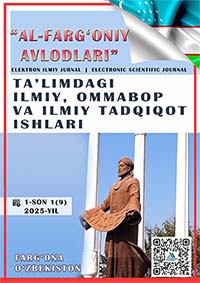ADAPTIVE TRAJECTORY FORMATION ALGORITHMS FOR IMPROVING AUTOMATIC FINISHING OF UNDEFINITE SURFACES IN ROBOT MANIPULATORS
Keywords:
Robotic manipulators, Adaptive trajectory, Uncertain surfaces, Automatic finishing, Sensory analysis, Real-time controlAbstract
This article analyzes the energy efficiency of a new multicyclone device. The focus is on identifying strategies to reduce energy consumption and increase efficiency and justifying them using mathematical models. The analysis is carried out on the basis of in-depth mathematical modeling of the aerodynamic forces in the cyclone, the energy lost due to pressure drop, and the overall efficiency of the device. As a result of the analysis, new design proposals are introduced to further increase energy efficiency, and these proposals are mathematically justified, which are aimed at minimizing energy consumption.
References
Хайитов А.М. МЕХАТРОННАЯ СИСТЕМА УПРАВЛЕНИЯ ДВИЖЕНИЕМ МАНИПУЛЯТОРА ПРИ ОКРАСКЕ ИЗДЕЛИЙ // Universum: технические науки : электрон. научн. журн. 2025. 5(134).
Xayitov A., Kayumov A. ANDROID APPLICATION TESTING AND CODE RE-FACTORING //Conference on Digital Innovation:" Modern Problems and Solutions".–2023.
Siciliano, B., & Khatib, O. (Eds.). (2016). Springer handbook of robotics (2nd ed.). Springer. https://doi.org/10.1007/978-3-319-32552-1
Craig, J. J. (2018). Introduction to robotics: Mechanics and control (4th ed.). Pearson.
Quigley, M., Conley, K., Gerkey, B., Faust, J., Foote, T., Leibs, J., ... & Ng, A. Y. (2009). ROS: An open-source Robot Operating System. ICRA Workshop on Open Source Software, 3(3.2), 5.
Khalil, W., & Dombre, E. (2004). Modeling, identification and control of robots. Butterworth-Heinemann.
Schilling, R. J. (2017). Fundamentals of robotics: Analysis and control. Pearson.
Tsai, L.-W. (1999). Robot analysis: The mechanics of serial and parallel manipulators. John Wiley & Sons.
Siciliano, B., Sciavicco, L., Villani, L., & Oriolo, G. (2009). Robotics: Modelling, planning and control. Springer. https://doi.org/10.1007/978-1-84628-642-1
Thrun, S., Burgard, W., & Fox, D. (2005). Probabilistic robotics. MIT Press.
Hutterer, T., & Hirz, M. (2020). Adaptive robot path planning for automotive surface finishing based on real-time surface evaluation. Procedia CIRP, 94, 304–309. https://doi.org/10.1016/j.procir.2020.09.091
Zhang, H., Chen, H., Xu, C., & Luo, X. (2021). A hybrid trajectory generation approach for robotic polishing of free-form surfaces. Robotics and Computer-Integrated Manufacturing, 68, 102065. https://doi.org/10.1016/j.rcim.2020.102065
Fang, B., Zhang, Y., & Gong, C. (2019). Adaptive force control for robotic surface processing with uncertain contact model. Journal of Intelligent & Robotic Systems, 95(1), 117–132. https://doi.org/10.1007/s10846-018-0879-6
Siciliano, B. (2010). Robotics: Modelling, planning and control. Springer Science & Business Media.
Goodfellow, I., Bengio, Y., & Courville, A. (2016). Deep learning. MIT Press.
Papon, J., Abramov, A., Schoeler, M., & Worgotter, F. (2013). Voxel cloud connectivity segmentation—Supervoxels for point clouds. Proceedings of the IEEE Conference on Computer Vision and Pattern Recognition, 2027–2034.
Additional Files
Published
How to Cite
Issue
Section
Categories
License
Copyright (c) 2025 Azizjon Xayitov

This work is licensed under a Creative Commons Attribution 4.0 International License.












